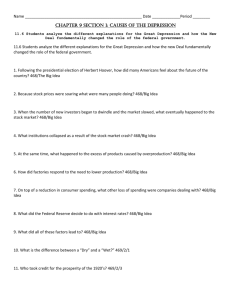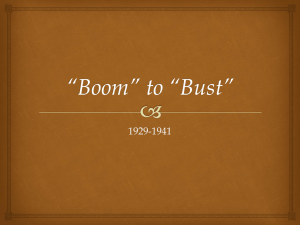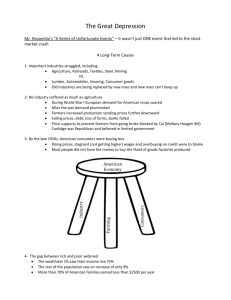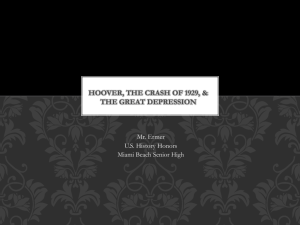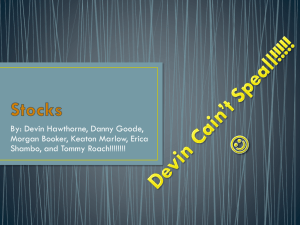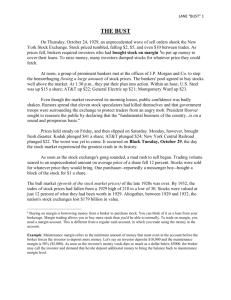Lesson 21-1: Hoover As President
advertisement
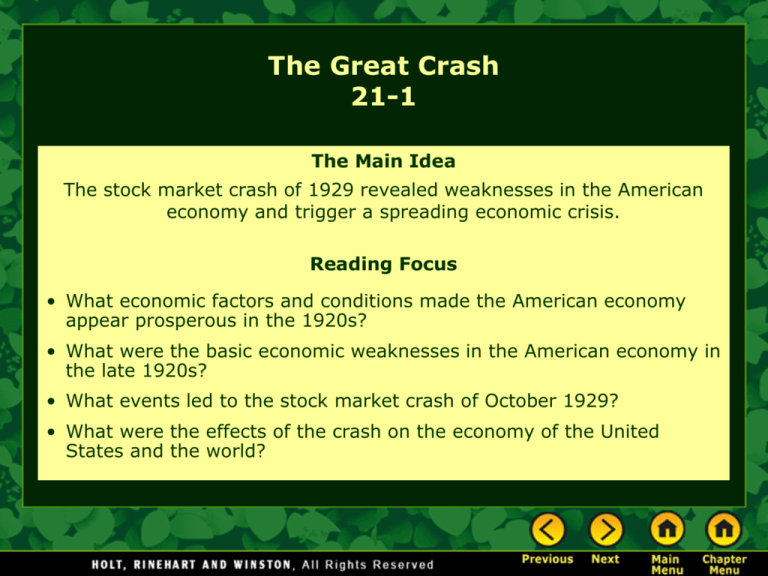
The Great Crash 21-1 The Main Idea The stock market crash of 1929 revealed weaknesses in the American economy and trigger a spreading economic crisis. Reading Focus • What economic factors and conditions made the American economy appear prosperous in the 1920s? • What were the basic economic weaknesses in the American economy in the late 1920s? • What events led to the stock market crash of October 1929? • What were the effects of the crash on the economy of the United States and the world? The Appearance of Prosperity Strong Economy Strong Stock Market • Between 1922 and 1928 the U.S. gross national product, or total value of all goods and services, rose 40 percent. • The stock market, where people buy stocks, or shares, in companies, performed very well in the 1920s, with stock values sharply increasing each month. • Though farmers and some other workers didn’t benefit, the overall economy performed well, especially for automakers and those who made auto parts. • Overall unemployment remained low, averaging around five percent between 1923 and 1929. • Union membership slowed as employers expanded welfare capitalism programs, or employee benefits. • This feeling of prosperity encouraged workers to buy new products and enjoy leisure activities such as movies. • The value of stocks traded quadrupled over nine years. • The steep rise in stock prices made people think the market would never drop, and more ordinary Americans bought stocks than ever before. • The number of shares traded rose. • Business leaders said everyone could get rich from stocks. – John Raskob Everyone Ought To Be Rich High Hopes Faith in business and government • Many Americans thought the prosperity of the 1920s proved the triumph of American business, and public confidence in government was high. • Presidents Harding and Coolidge both favored policies that helped business, and both were very popular, easily winning elections. The election of 1928 • When Coolidge didn’t run for reelection in 1928, the Republicans easily chose Herbert Hoover. • Hoover had been on Harding and Coolidge’s cabinets, had overseen America’s food production during World War I, and had an outstanding reputation as a business-like administrator. • Hoover’s opponent was New York governor Al Smith, an outgoing politician with a strong Brooklyn accent, whose support came mostly from cities. • Smith was the first Catholic to run for president. He faced prejudice because of his religion, and because of his opposition to Prohibition. • Hoover easily won the election, but the race clearly demonstrated the conflicts dividing the nation in that era. Economic Weaknesses • While many Americans enjoyed good fortune in the 1920s, many serious problems bubbled underneath the surface. • One problem in the American economy was the uneven distribution of wealth during the 1920s. – The wealthiest one percent of the population’s income grew 75 percent, but the average worker saw under a 10 percent gain. • For most Americans, rising prices swallowed up any increase in salary. • Coal miners and farmers were very hard hit, but by 1929 over 70 percent of U.S. families had too low an income for a good standard of living. • Four out of every five families couldn’t save any money during the socalled boom years. • Credit allowed Americans to buy expensive goods, but by the end of the decade many people reached their credit limits, and purchases slowed. • Warehouses became filled with goods no one could afford to buy. Credit and the Stock Market Investors increasingly used credit to buy stocks as the market rose. Buying on Margin • Investors were buying on margin, or buying stocks with loans from stockbrokers, intending to pay brokers back when they sold the stock. • As the market rose, brokers required less margin, or investors’ money, for stocks and gave bigger loans to investors. • Buying on margin was risky, because fallen stocks left investors in debt with no money. • If stocks fell, brokers could ask for their loans back, which was called a margin call. The Federal Reserve • The board of the Federal Reserve, the nation’s central bank, worried about the nation’s interest in stock and decided to make it harder for brokers to offer margin loans to investors. • Their move was successful, until money came from a new source: American corporations who were willing to give brokers money for margin loans. • Buying continued to rise. The Stock Market Crashes • The steady growth of the early 1920s gave way to astounding gains at the end of the decade until its September 3, 1929, peak. • Dow Jones Industrial Average • • Average of stock prices of major industries Many people were beginning to see trouble as consumer purchasing fell and rumors of a collapse circulated. • On Thursday, October 24, 1929, some nervous investors began selling their stocks and others followed, creating a huge sell-off with no buyers. • Stock prices plunged, triggering an even greater panic to sell. • Toward the end of the day, leading bankers joined together to buy stocks and prevent a further collapse, which stopping the panic through Friday. • But the next Monday the market sank again, and Black Tuesday, October 29, was the worst day, affecting stocks of even solid companies. The Stock Market Crashes • The damage was widespread and catastrophic. In a few short days the market had dropped in value by about $16 billion, nearly one half of its pre-crash value. • The stock market crash was part of the business cycle – Periods in which the economy grows and then shrinks Effects of the Crash Impact on Individuals • Though some thought the market would rally, countless individual investors were ruined. • Margin buyers were hit the hardest, because brokers demanded they pay back the money they had been loaned. • To repay the loans, investors were forced to sell their stocks for far less than they had paid, and some lost their entire savings making up the difference. • In the end, many investors owed enormous amounts of money to their brokers, with no stocks or savings left to pay their debts. Effects on Banks • The crash triggered a banking crisis, as frightened depositors rushed to withdraw their money, draining the bank of funds. • Many banks themselves had invested directly or indirectly in the stock market by buying companies’ stocks or by lending brokers money to loan to investors on margin. • When investors couldn’t repay margins, banks lost money, too. • These failures drove many banks out of business. More Effects of the Crash Impact on Business • The crash crushed businesses, because banks couldn’t lend money. • Consumers also cut back their spending on everything but essentials, and companies were forced to lay off workers when demand decreased. Impact on Europe • The fragile economies of Europe were still struggling from World War I. They had borrowed a great deal of money from American banks that the banks now wanted back. • Unemployed workers had even less money to make purchases, and the cycle continued. • With U.S. buying power down, foreign businesses were less able to export their products and were forced to fire workers. • In the year after the crash, American wages dropped by $4 billion and nearly 3 million people lost their jobs. • Governments tried to protect themselves by passing high tariffs, making foreign goods expensive. The decline in world trade in the 1930s created misery around the world and contributed to the nation’s slide into the Great Depression. Economic Danger Signs of • Stock market crash was not the cause of the Great Depression, it was just the final push • Danger Signs – – – – – Uneven prosperity Buying on credit Playing stock market/buying on margin Too many goods, too little demand Economic trouble for farmers Click on the window to start video

